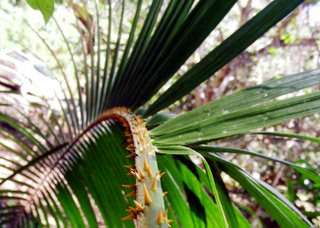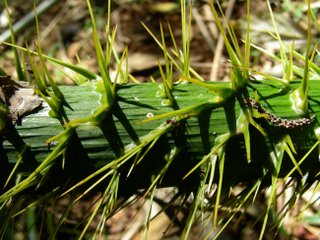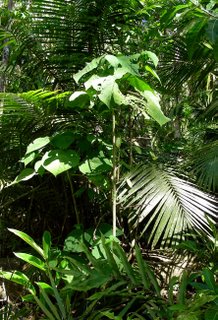We know that North Queensland's aquatic life can give you something to think about. But what of life on land? Is a wander through the rainforest fraught with danger?
Not really. Oh, sure, a cassowary can disembowel you. And an amethystine python might give you a friendly squeeze. But the fauna is otherwise pretty benign.
The plants are another matter.
 Calamus, a genus of climbing palms, loves disturbed areas. You'll see thickets of it sprouting along the edges of forest paths or in clearings formed by fallen trees. Several species are common in the rainforests of Far North Queensland. All of them are covered in vicious spines. Just how vicious depends on the species.
Calamus, a genus of climbing palms, loves disturbed areas. You'll see thickets of it sprouting along the edges of forest paths or in clearings formed by fallen trees. Several species are common in the rainforests of Far North Queensland. All of them are covered in vicious spines. Just how vicious depends on the species.Despite the weaponry, the larger Calamus palms are harvested for rattan. This industry is small in Australia but is a major one throughout South East Asia.
 The spines on the stems of Calamus protect it from large herbivores. Those on the fronds and tendrils also make an unpleasant mouthful but they have another function: they act as grapnels when the plant is climbing. If you've ever been snagged on the wire-fine tendril of Calamus australis, you'll know how difficult it is to free yourself. They're called lawyer vines for a reason.
The spines on the stems of Calamus protect it from large herbivores. Those on the fronds and tendrils also make an unpleasant mouthful but they have another function: they act as grapnels when the plant is climbing. If you've ever been snagged on the wire-fine tendril of Calamus australis, you'll know how difficult it is to free yourself. They're called lawyer vines for a reason. Still, Calamus is an amateur when it comes to inflicting pain. Stinging trees (Dendrocnide moroides) are much more effective. They look harmless enough, lining forest paths in the company of picturesque bangalow palms (Archontophoenix) and wild ginger (Alpinia) with their giant, heart-shape leaves and caterpillar-munched perforations. If an insect can chew on them, they can't be that bad. Right? Right?
Still, Calamus is an amateur when it comes to inflicting pain. Stinging trees (Dendrocnide moroides) are much more effective. They look harmless enough, lining forest paths in the company of picturesque bangalow palms (Archontophoenix) and wild ginger (Alpinia) with their giant, heart-shape leaves and caterpillar-munched perforations. If an insect can chew on them, they can't be that bad. Right? Right?The sting probably won't kill you but you might well want to die if you brush up against the tree. Each leaf is covered in fine, hollow hairs made of silica, as sharp as broken glass and just as brittle. They snap off in the skin. But that isn't all. The hairs deliver tiny amounts of a neurotoxin. One hair, one microdose, no problem. Hundreds of hairs, hundreds of microdoses ... big problem.
 The toxin is remarkably stable. It hangs around in the hairs for a long time. Contact with the affected area of skin will release it into the surrounding tissue, as will changes in temperature. And that includes hot water from showers or cool sea water. Apparently, the recommended solution for a sting is to apply those wax strips used in depilation.
The toxin is remarkably stable. It hangs around in the hairs for a long time. Contact with the affected area of skin will release it into the surrounding tissue, as will changes in temperature. And that includes hot water from showers or cool sea water. Apparently, the recommended solution for a sting is to apply those wax strips used in depilation.But by far the best method is to avoid them. You know what they look like. Keep clear of the buggers. And never, ever use them as toilet paper.